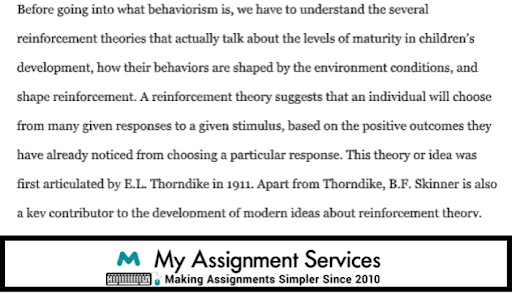Highlights
Bloom’s taxonomy refers to a hierarchical system of categorizing psychomotor skills or domains and cognitive-affective to help the students learn and teachers for teaching. It provides a common language for the students and teachers to discuss and exchange assessment and learning methods. According to My Assignment Services’ experts, the framework helps educators in developing learning objectives for a particular course. The cognitive domain is linked with intellectual skills and expands knowledge in this framework. The affective domain is coupled with the growth of emotional or feeling aspects of an individual. Psychomotor explain the enhancement of manual or physical skills. Bloom’s Taxonomy Assignments require higher-order thinking skills necessary to accomplish the learning objectives of bigger complexities. We assume you are anxious about your assignment and are looking for Bloom's Taxonomy Assignment Help online. My Assignment Services is here to provide you with online guided sessions where you can instantly clear your doubts and complete your bloom’s taxonomy assignment easily.

Bloom’s taxonomy derived its name from Benjamin Bloom, the head of the educational committee that devised the taxonomy. It is a three-rank hierarchical structure. It explains the analyzing and thinking skills by following a specific order. This model supports placing the intellectual abilities in varying sections such that few orders of complexity and specificity can be enveloped. For example, the writer does not explain a single sequence for structuring a passage. Scholars use Bloom's taxonomy to understand better and learn a subject, where teachers use it in teaching.
Bloom’s taxonomy comprises varying layers of emotions and understanding. To learn about these uneven layers, we resort to applying them. The three levels of Bloom’s taxonomy are mentioned below. But should you need further clarification of any concept, simply contact us to avail our Bloom's Taxonomy Assignment Help. We offer online one-to-one sessions and will clear all your doubts related to your assignments so that you can prepare impressive work.
It incorporates knowledge and the development of intellectual skills. In regard to complexity levels, there are six subsections of the cognitive domain:
It considers the emotions and the feelings linked with the passage. It can comprise phenomena, ideas, characters, and conscience (Begam & Tholappan, 2018). The significant part of the affective domain utilized while applying Bloom's taxonomy is characterization, values, reception, organization, and response. There are five stages in the affective domain in ascending order of consequences:
It includes sensory organ movement, coordination, and the physical mobility of the body as a unit. If you wish to become professional at such skills, much practice is required. Bloom's taxonomy examples regard the action of playing keyboards, driving, guitar, and others as primary examples of this domain.
Online Assignment Help
Custom Essay Help
Dissertation Writing Service
At first, the taxonomy comprised only one dimension: cognitive processes. However, the revised taxonomy launched the knowledge dimensions, which indicate the kind of knowledge to be learned (Irvine, 2017). Our experts who provide Bloom's Taxonomy Assignment Help have advanced knowledge of all the dimensions. Feel free to speak or chat with us and get your queries answered within seconds. These knowledge dimensions are:
Our bloom's taxonomy assignment help experts will show you how to apply the framework in an inappropriate manner.
The main issue in reading a long passage is recalling all the course's significant factors. You are required to read it several times, which will be both energy and time-consuming. According to our Australianassignment help expert’s following practices are significant to manage such a scenario effectively:
Bloom's Taxonomy Assignment Sample by Our Experts


The ultimate motive of our experts is to help students understand Bloom’s taxonomy. Our experts will help you know what it is, how it functions, and how to apply the training and evaluation procedure. Bloom's Taxonomy Assignments have evolved immensely over time and provide several positive advantages for educators and learners. Our experts, through online guided sessions, will explain to you Bloom’s six levels of thinking; how to use or apply Bloom's taxonomy whenever creating a course or lesson; to understand the three key domains, which are cognitive, affective, and psychomotor; and how to use Bloom’s taxonomy for both summative as well as formative assessments to aid in active learning. Here is a Bloom's Taxonomy Assignment sample provided by our experts:
The framework gives a well-organized structure that every trainer, tutor, and teacher needs to learn efficiently. Here are some of the following features of our Bloom's Taxonomy Assignment Help:
24 X 7 Support
100+ Subjects Covered
2000+ Ph.D Experts
Begam, A.A A., & Tholappan, A. (2018). The psychomotor domain of Bloom's taxonomy in teacher education.Shanlax International Journal of Education,6(3), 11-14. https://doi.org/10.1109/ISCAIE.2019.8743903
Irvine, J. (2017). A Comparison of Revised Bloom and Marzano's New Taxonomy of Learning.Research in Higher Education Journal,33. Retrieved from: 1128-T46.pdf (ijiet.org)
1,212,718Orders
4.9/5Rating
5,063Experts
Turnitin Report
$10.00Proofreading and Editing
$9.00Per PageConsultation with Expert
$35.00Per HourLive Session 1-on-1
$40.00Per 30 min.Quality Check
$25.00Total
FreeBonanza Offer
Get 40% Off *
on your assignment today
Doing your Assignment with our samples is simple, take Expert assistance to ensure HD Grades. Here you Go....